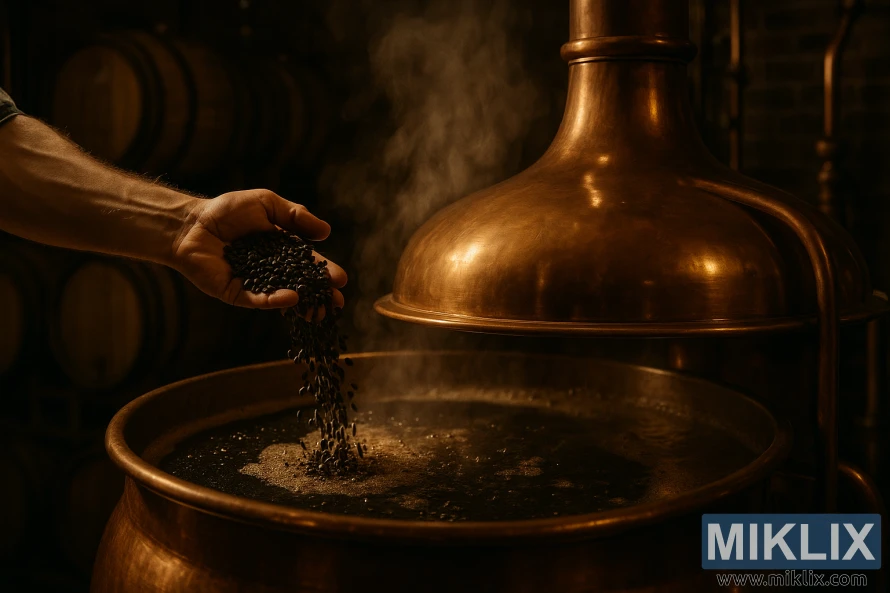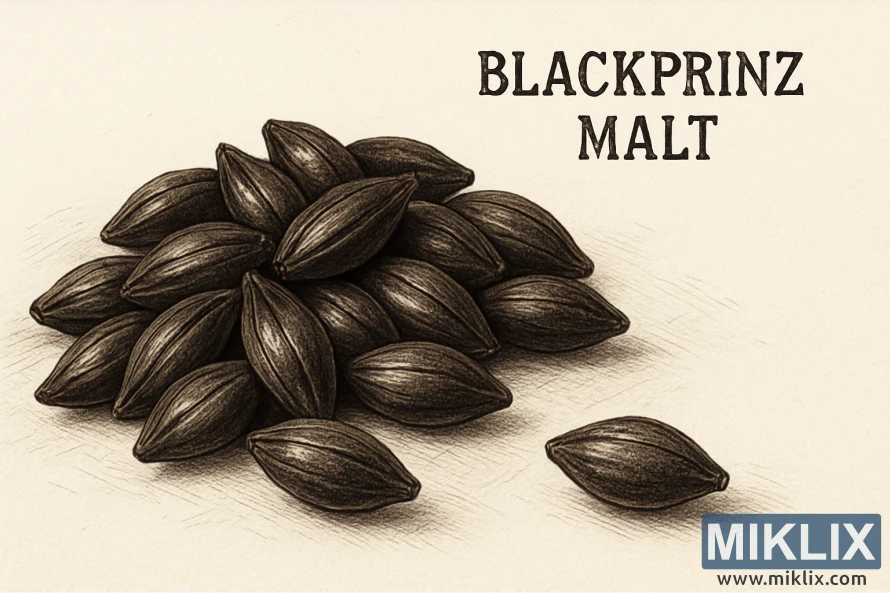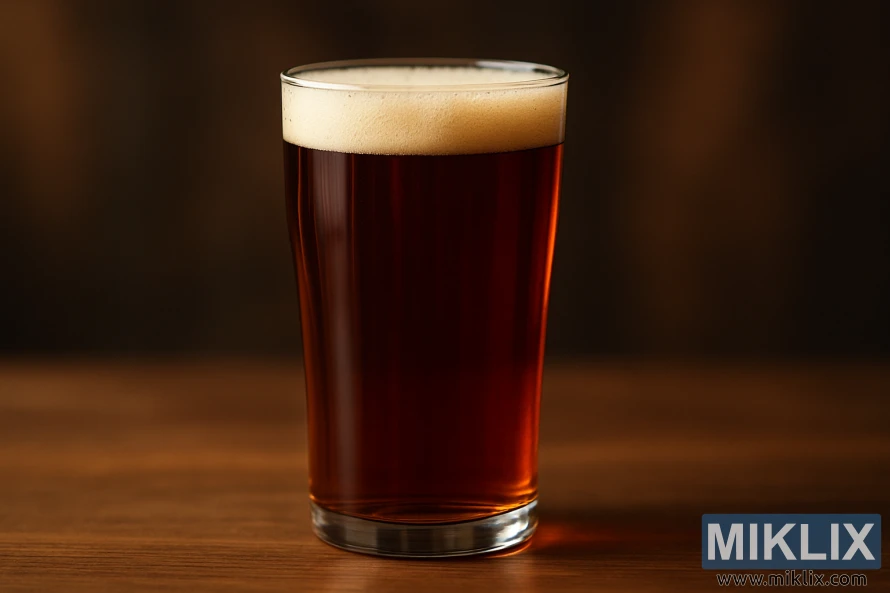Brewing Beer with Blackprinz Malt
Published: July 25, 2025 at 7:53:02 AM UTC
Brewing beer with Blackprinz malt introduces a unique twist to traditional recipes. This dehusked malt is celebrated for its clean roasted flavor and low bitterness. It's perfect for crafting smooth, balanced beers. Using Blackprinz malt results in beers with a smoother, less astringent character. It's ideal for those aiming to create beers with a rich, roasted taste. Yet, it avoids the harshness found in traditional black malts.

Key Takeaways
- Blackprinz malt provides a clean roasted flavor with low bitterness.
- Ideal for brewing smooth and balanced beers.
- Offers a smoother character compared to traditional black malt.
- Suitable for brewers seeking rich, roasted flavors without harshness.
- Enhances the overall quality of the beer.
Understanding Blackprinz Malt: An Overview
Blackprinz malt, with its dehusked barley base, offers brewers a cleaner and smoother roast flavor. This makes it a great choice for brewing a wide range of beer styles.
The production of Blackprinz malt involves dehusking the barley before malting. This step significantly reduces the harshness and bitterness found in traditional dark malts. As a result, it provides a rich, roasted flavor without the astringency that can come from husk material.
- Clean roasted flavor profile
- Low bitterness due to the dehusking process
- Versatile for use in various beer styles
Brewing with Blackprinz malt opens up a world of creativity in recipe formulation. Its mild roast character is perfect for a variety of beer styles, from dark ales to stouts. By using Blackprinz malt, brewers can create complex flavor profiles without the harshness of some traditional dark malts.
In summary, Blackprinz malt is a valuable ingredient for brewers aiming to add depth and richness to their beers without bitterness. Its unique production process and characteristics make it a versatile and desirable brewing ingredient.
The Science Behind Dehusked Malts
For brewers aiming to innovate, understanding dehusked malts is key. Malts like Blackprinz are popular for adding depth and complexity to beers. They do this without the harsh, roasted flavors dark malts often bring.
The dehusking process removes the outer husk of the malt. This significantly impacts the flavor and aroma compounds. By removing the husk, brewers can avoid bitter flavors, leading to a smoother taste.
Dehusked malts, such as Blackprinz, allow brewers to achieve dark colors without heavy roasted flavors. This makes them perfect for various beer styles. For example, Black IPAs benefit from debittered dark malts, achieving dark colors without overpowering hop flavors.
- Key benefits of dehusked malts include a cleaner flavor profile and reduced bitterness.
- The aroma is also affected, with dehusked malts contributing a more subtle character to the beer.
- Brewers can experiment with different ratios of dehusked malts to achieve the desired flavor and color.
The science behind dehusked malts is rooted in malting chemistry. By controlling husk removal and malting parameters, maltsters can create malts with specific characteristics. These malts meet brewers' needs, allowing for innovation in recipes.
Technical Specifications of Blackprinz Malt
The technical specifications of Blackprinz malt, including its moisture content and SRM, are vital for achieving the desired beer quality. Blackprinz malt is characterized by its distinct technical attributes that make it a valuable ingredient in brewing.
Blackprinz malt has a moisture content of 6%, which is a critical factor in its storage and handling. Proper storage conditions are necessary to maintain this moisture level and ensure the malt's quality over time.
The SRM (Standard Reference Method) of Blackprinz malt is 500, indicating its intense color contribution to beer. This characteristic makes it an ideal choice for brewers seeking to achieve a deep, dark color in their beers.
When it comes to usage levels, Blackprinz malt is typically used in small quantities due to its potent flavor and color characteristics. The exact usage rate can vary depending on the specific beer style being brewed and the desired intensity of flavor and color.
Here are some key technical specifications of Blackprinz malt:
- Moisture content: 6%
- SRM: 500
- Usage levels: Typically between 1-5% of the total grist
Understanding these technical specifications is critical for brewers. It helps them effectively incorporate Blackprinz malt into their brewing processes. This ensures they achieve the desired outcomes in their beers.

Flavor Profile and Aromatic Characteristics
Blackprinz malt brings a smooth, subtle flavor to various beer styles. It offers hints of chocolate and coffee, enriching the taste experience. This makes it a key ingredient in brewing.
The aroma of Blackprinz malt is equally captivating. Brewers often describe it as having a deep, roasted scent. This aroma complements the beer's flavor, making it a standout ingredient.
Key characteristics of Blackprinz malt include:
- Smooth and subtle flavor profile
- Hints of chocolate and coffee
- Deep, roasted aroma
- Contributes to complex beer styles
Understanding Blackprinz malt's flavor and aroma allows brewers to craft unique beers. These beers are both nuanced and full-bodied, thanks to this malt.
Comparing Blackprinz to Traditional Dark Malts
In the realm of craft brewing, Blackprinz malt is emerging as a viable alternative to traditional dark malts. But what sets them apart?
Blackprinz malt and traditional dark malts exhibit unique characteristics that influence beer's flavor and aroma. Blackprinz is celebrated for its clean, roasted taste and low bitterness. This is due to its dehusked processing.
Traditional dark malts, by contrast, offer a broader spectrum of flavors. They can introduce sharper, more bitter notes. The decision between Blackprinz and traditional dark malts hinges on the brewer's desired taste.
- Blackprinz malt offers a smoother, roasted flavor.
- Traditional dark malts provide a wider range of flavor profiles.
- The processing of Blackprinz malt reduces bitterness.
By grasping the pros and cons of each, brewers can make well-informed choices about their ingredients.
Best Beer Styles for Blackprinz Malt
Brewing with Blackprinz malt opens a world of possibilities for complex and flavorful beers. It's well-suited for various styles due to its clean roasted flavor and low bitterness.
Some of the most popular beer styles that benefit from Blackprinz malt include:
- Stouts: Blackprinz malt adds a rich, roasted flavor to stouts without introducing harsh bitterness.
- Porters: The malt's roasted characteristics complement the traditional flavors of porters, enriching their depth.
- Brown Ales: Blackprinz malt can add complexity to brown ales with its subtle roasted notes.
- Strong Ales: For strong ales, Blackprinz malt contributes to a fuller body and a more complex flavor profile.
When brewing with Blackprinz malt, balancing the beer is key. The malt's characteristics can greatly impact the final product. Adjusting other ingredients is essential.
Recipes with Blackprinz malt vary widely. A common approach is to use it as a specialty malt to add depth and complexity. For instance, a robust porter recipe might include Blackprinz malt as a primary component. In contrast, a brown ale recipe might use it in smaller quantities to enhance the malt's subtle roasted flavors.
Understanding how to use Blackprinz malt in different beer styles allows brewers to create a wide range of delicious and balanced beers. These beers showcase the malt's unique qualities.

Recipe Formulation Guidelines
To maximize Blackprinz malt's benefits, brewers must consider several key factors in recipe formulation. This malt, known for its versatility, can elevate the flavor of various beer styles. Yet, its robust character demands careful balancing with other ingredients.
Understanding Blackprinz malt's impact on flavor and aroma is critical. It offers a clean roasted taste and low bitterness. This makes it perfect for brewers aiming to add depth without harshness.
Here are some guidelines for incorporating Blackprinz malt into your recipes:
- Start with a small percentage of Blackprinz malt (around 5-10%) to gauge its impact on the beer's flavor profile.
- Balance the roasted flavor with complementary ingredients, such as specialty malts or hops with similar flavor profiles.
- Consider the beer's style and how Blackprinz malt will contribute to its overall character. For example, it pairs well with styles that require a deep, malty flavor.
- Adjust the brewing process as needed to optimize the extraction of flavors from Blackprinz malt.
Brewing with Blackprinz malt also involves understanding its interaction with other ingredients. For instance, pairing it with certain hop varieties can enhance the beer's overall aroma and flavor complexity.
By following these guidelines and experimenting with different recipe formulations, brewers can unlock the full Blackprinz malt benefits. This leads to creating unique, high-quality beers that stand out in the market.
Mashing Techniques and Parameters
Optimizing mashing techniques is key when brewing with Blackprinz malt to bring out its full flavor. The mashing process sets the foundation for the beer's taste. Blackprinz malt, with its distinct traits, demands careful attention.
When mashing with Blackprinz malt, focus on the mash temperature and duration. Aim for a temperature between 152°F and 155°F (66°C to 68°C) for a balance between fermentability and flavor extraction. A longer mash can help extract more complex flavors from the malt.
The water-to-grain ratio is also critical. A thicker mash can lead to better flavor extraction but may increase the risk of a stuck mash. Brewers should experiment to find the best ratio for their setup and recipe.
Here are some key considerations for mashing with Blackprinz malt:
- Maintain a consistent mash temperature for even extraction.
- Monitor the mash pH to avoid unwanted compound extraction.
- Adjust the water-to-grain ratio based on malt specific gravity and desired beer style.
By controlling these mashing parameters, brewers can unlock Blackprinz malt's full flavor. Whether making a dark ale or a robust stout, the right mashing techniques are essential for a great final product.
The Impact on Beer Color Development
Using Blackprinz malt in brewing can greatly affect beer color, giving brewers a way to adjust their beer's look. This malt is renowned for adding a deep, rich color to beer, even in small amounts.
- The malting process, which includes dehusking, changes how the malt interacts with other ingredients during brewing.
- The specific kilning temperatures used for Blackprinz malt help to develop its characteristic color and flavor compounds.
- The type of beer being brewed, including factors like the grain bill and brewing techniques, influences how Blackprinz malt impacts the final color.
To achieve the desired color, brewers can adjust the proportion of Blackprinz malt in their recipe. Here are some guidelines:
- For darker beers, such as stouts and porters, a higher percentage of Blackprinz malt may be used to achieve the desired color and flavor profile.
- In lighter beers, even a small amount of Blackprinz malt can impart a rich, complex color without overpowering the other flavors.
- Experimenting with different mashing temperatures and techniques can also influence how Blackprinz malt contributes to the beer's color.
By understanding how Blackprinz malt affects beer color development, brewers can more effectively create recipes that achieve the desired appearance and overall character.

Common Brewing Challenges and Solutions
To achieve the best results with Blackprinz malt, brewers must be aware of common issues and their solutions. Blackprinz malt is known for its clean roasted flavor and low bitterness. It can introduce specific challenges during the brewing process.
Common issues brewers face include difficulties with mash filtration, achieving consistent color development, and managing the flavor profile.
To address these challenges, brewers can implement several strategies. For mash filtration issues, adjusting the mash temperature or using a lauter tun with a finer mesh can be beneficial. For consistent color development, ensuring accurate malt quantity and monitoring the brewing process can help.
- Monitoring mash pH to ensure optimal enzyme activity
- Adjusting the grist composition to improve lautering efficiency
- Verifying the moisture content of the malt to ensure consistency
By understanding the common brewing challenges associated with Blackprinz malt and implementing the right solutions, brewers can optimize their brewing process. This leads to producing high-quality beers.
Storage and Handling Requirements
To ensure the longevity and potency of Blackprinz malt, brewers must adhere to specific storage and handling guidelines. Proper storage conditions are vital for preserving the quality and freshness of brewing ingredients like Blackprinz malt.
Blackprinz malt should be stored in a cool, dry environment, away from direct sunlight and moisture. The ideal storage temperature is between 50°F to 70°F (10°C to 21°C), with minimal exposure to humidity. This helps in preventing the degradation of the malt's flavor and aroma.
Handling practices also play a significant role in maintaining the quality of Blackprinz malt. Brewers should handle the malt in a way that minimizes exposure to air, as prolonged exposure can lead to staling. It's recommended to store the malt in airtight containers or bags that are designed for storing grains.
- Store Blackprinz malt in a cool, dry place.
- Maintain a storage temperature between 50°F to 70°F (10°C to 21°C).
- Minimize exposure to humidity and direct sunlight.
- Use airtight containers or bags to prevent staling.
By following these storage and handling guidelines, brewers can ensure that their Blackprinz malt remains fresh and effective. This contributes to the production of high-quality beers with the desired flavor profiles.
Commercial Brewing Applications
Blackprinz malt stands out for its versatility in commercial brewing, fitting perfectly into dark ales and stouts. Its dehusked nature and clean roasted taste make it a top choice for brewers aiming to craft complex, rich beers on a large scale.
Commercial breweries are turning to Blackprinz malt for a broad spectrum of beer styles. Its consistent quality and flavor profile are key for large-scale production, where uniformity is essential. The malt's low bitterness and rich, roasted taste enhance the beer's character without dominating it.
Using Blackprinz malt in commercial brewing offers several benefits. It adds depth and complexity to beers without harsh bitterness. This makes it ideal for porters, stouts, and dark lagers. Its dehusked nature also contributes to smoother fermentation, potentially reducing off-flavors.
Key considerations for brewers using Blackprinz malt include:
- Optimizing mashing parameters to extract the desired flavor compounds
- Balancing the malt bill to achieve the perfect blend of flavors
- Monitoring fermentation closely to ensure that the unique characteristics of Blackprinz malt are preserved
By mastering the unique properties of Blackprinz malt, commercial brewers can create innovative, high-quality beers. Whether brewing traditional styles or exploring new recipes, Blackprinz malt provides a reliable base for your creations.
Creating Complex Malt Bills with Blackprinz
Creating a complex malt bill with Blackprinz malt demands a deep understanding of its characteristics. It's known for its clean roasted flavor and low bitterness, thanks to being dehusked. This makes it a valuable tool for adding depth to beers without harsh bitterness.
To effectively create complex malt bills, brewers should consider the following tips:
- Start by understanding the base malt and how Blackprinz malt will complement or contrast with it.
- Experiment with different ratios of Blackprinz to other specialty malts to achieve the desired flavor profile.
- Consider the beer's overall style and how the characteristics of Blackprinz malt will contribute to it.
When balancing flavor and aroma, remember that Blackprinz malt adds a rich, roasted flavor without bitterness. This makes it perfect for brewers aiming to add complexity to their malt bills.
Some key considerations when formulating a recipe with Blackprinz malt include:
- Determining the proportion of Blackprinz malt to use based on the desired intensity of roasted flavor.
- Selecting complementary specialty malts that enhance the characteristics of Blackprinz without overpowering it.
- Adjusting brewing parameters, such as mash temperature, to optimize the extraction of flavors from Blackprinz and other malts.
By carefully considering these factors and experimenting with different combinations, brewers can create complex and delicious malt bills. These showcase the unique qualities of Blackprinz malt.
Quality Control Measures
To maximize the benefits of Blackprinz malt, brewers must adhere to strict quality control protocols. Ensuring the malt's quality is critical for achieving the desired flavor and color in the final brew.
Quality control starts with proper storage and handling of Blackprinz malt. It's essential to store it in a cool, dry place, away from sunlight and moisture. Brewers should inspect the malt for any damage or deterioration before brewing.
During brewing, monitoring mash temperature, pH, and extraction efficiency is key to consistency. Regular checks on brewing equipment are also necessary to prevent contamination and maintain hygiene standards.
- Verify the specifications of Blackprinz malt upon delivery.
- Monitor storage conditions to prevent degradation.
- Check brewing equipment regularly.
- Maintain precise control over brewing parameters.
By implementing these quality control measures, brewers can ensure their beer meets the highest standards of quality and consistency when using Blackprinz malt.
Sustainability Aspects of Blackprinz Production
The brewing industry's evolution has highlighted the importance of sustainability, including in malt production like Blackprinz. The process of making Blackprinz malt focuses on quality while also reducing environmental harm.
The brewing sector is a major user of water and energy, with malt production being a key step. Adopting sustainable practices in malt making can greatly lessen brewing's environmental effects. This includes using water more efficiently, cutting down on energy use, and reducing waste.
- Adoption of energy-efficient malting processes
- Implementation of water-saving technologies
- Reduction of waste through recycling and reuse
- Use of sustainable raw materials
By embracing these sustainable methods, Blackprinz malt production enhances beer quality and aids the brewing industry's environmental goals. Brewers can make better choices about their practices and ingredients by understanding these sustainability aspects.

Conclusion
Mastering Blackprinz malt can significantly enhance your brewery's offerings. It adds a clean roasted flavor and low bitterness, perfect for various beer styles. Understanding its technical specifications, flavor profile, and best brewing practices opens up new possibilities in your recipes.
To maximize Blackprinz malt, focus on precise mashing techniques. Also, consider its impact on beer color development. By following the guidelines in this article, you can craft complex and balanced beers. These will showcase Blackprinz malt's unique characteristics.
Incorporating Blackprinz malt into your brewery can be transformative, whether you're experienced or new. With these tips and a dedication to quality, you'll master Blackprinz malt. This will help you create exceptional beers that will impress your customers.
Further Reading
If you enjoyed this post, you may also like these suggestions:
